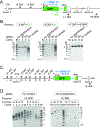Introducing a Spectrum of Long-Range Genomic Deletions in Human Embryonic Stem Cells Using Type I CRISPR-Cas
- PMID: 30975459
- PMCID: PMC6555677
- DOI: 10.1016/j.molcel.2019.03.014
Introducing a Spectrum of Long-Range Genomic Deletions in Human Embryonic Stem Cells Using Type I CRISPR-Cas
Abstract
CRISPR-Cas systems enable microbial adaptive immunity and provide eukaryotic genome editing tools. These tools employ a single effector enzyme of type II or V CRISPR to generate RNA-guided, precise genome breaks. Here we demonstrate the feasibility of using type I CRISPR-Cas to effectively introduce a spectrum of long-range chromosomal deletions with a single RNA guide in human embryonic stem cells and HAP1 cells. Type I CRISPR systems rely on the multi-subunit ribonucleoprotein (RNP) complex Cascade to identify DNA targets and on the helicase-nuclease enzyme Cas3 to degrade DNA processively. With RNP delivery of T. fusca Cascade and Cas3, we obtained 13%-60% editing efficiency. Long-range PCR-based and high-throughput-sequencing-based lesion analyses reveal that a variety of deletions, ranging from a few hundred base pairs to 100 kilobases, are created upstream of the target site. These results highlight the potential utility of type I CRISPR-Cas for long-range genome manipulations and deletion screens in eukaryotes.
Keywords: CRISPR-Cas; Cas3; Cascade; RNA-guided; chromosome; embryonic stem cell; genome editing; large genome deletion; long-range; type I CRISPR.
Copyright © 2019 Elsevier Inc. All rights reserved.
Conflict of interest statement
Declaration of Interests
A patent application has been filed describing the invention reported herein.
Figures






Comment in
-
CRISPR-Cas3 Adds a Power Saw to the Toolbox for Human Genome Engineering.CRISPR J. 2019 Jun;2:150-152. doi: 10.1089/crispr.2019.29059.aha. CRISPR J. 2019. PMID: 31225749 No abstract available.
References
-
- Barrangou R, Fremaux C, Deveau H, Richards M, Boyaval P, Moineau S, Romero DA, and Horvath P (2007). CRISPR provides acquired resistance against viruses in prokaryotes. Science 315, 1709–1712. - PubMed
-
- Bolotin A, Quinquis B, Sorokin A, and Ehrlich SD (2005). Clustered regularly interspaced short palindrome repeats (CRISPRs) have spacers of extrachromosomal origin. Microbiology 151, 2551–2561. - PubMed
-
- Boyle EA, Andreasson JOL, Chircus LM, Sternberg SH, Wu MJ, Guegler CK, Doudna JA, and Greenleaf WJ (2017). High-throughput biochemical profiling reveals sequence determinants of dCas9 off-target binding and unbinding. Proceedings of the National Academy of Sciences of the United States of America 114, 5461–5466. - PMC - PubMed
Publication types
MeSH terms
Substances
Grants and funding
LinkOut - more resources
Full Text Sources
Other Literature Sources
Research Materials
Miscellaneous

